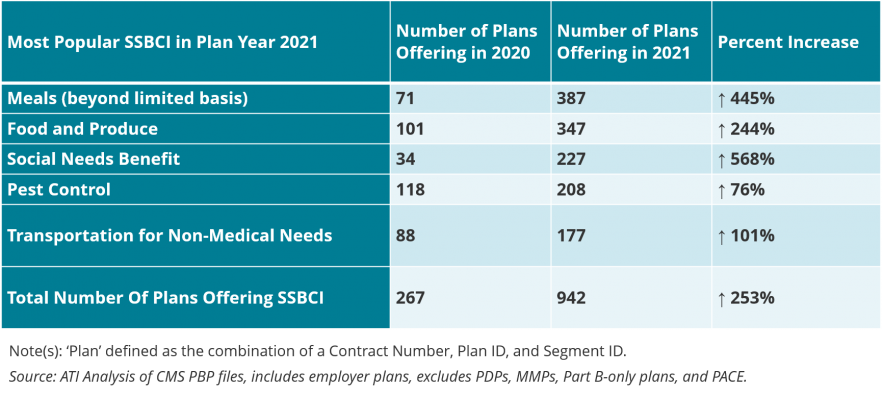By Christina Wu, Long-Term Quality Alliance and Elexa Rallos, ATI Advisory
The COVID-19 pandemic has laid bare the critical importance of addressing the health-related social needs of vulnerable populations, especially for older adults with complex care needs, as we highlighted in an earlier blog post. While traditional Medicare does not cover benefits to address social needs, Medicare Advantage (MA) plans have some flexibility to provide benefits — including food, prescription delivery, and housing supports — to meet the needs of members with complex chronic conditions. To maximize the potential of these new benefits, called Special Supplemental Benefits for the Chronically Ill (SSBCI), MA plans must take action to holistically serve the needs of chronically ill members using these benefits, form new partnerships with non-traditional service providers, and evaluate the impact of SSBCI on members’ health.
What are SSBCI?
Starting in 2020, Congress provided authority under the CHRONIC Care Act for MA plans to address members’ social needs through a new supplemental benefit category called SSBCI. While there are other pathways for MA plans to provide innovative, “LTSS-like” benefits (see pg. 23 of Policy Brief - Appendix D), SSBCI is the only option that allows plans to primarily address social determinants of health. For the first time, MA plans have authority to cover services such as pest control, social needs benefits, indoor air quality equipment and services, and more. SSBCI must be offered to MA members who meet the three-part eligibility criteria: (1) has one or more complex chronic conditions; (2) is at high risk for hospitalization or adverse health outcomes; and (3) requires intensive care coordination. These benefits can be tailored to meet the specific needs of the member and must have a reasonable expectation of improving or maintaining the health or overall function of the member.
Current SSBCI Landscape and Initial Health Plan Adoption
In 2021, nearly 1,000 MA plans are offering at least one SSBCI, up nearly four-fold from 2020, the first year these benefits could be offered. The share of MA plans offering SSBCI has also grown from 5% of MA plans in 2020 to 15% in 2021. Some of the largest increases occurred in benefits that can help address critical needs for a chronically ill population — particularly during the COVID-19 pandemic — such as food and produce, meals (beyond a limited basis), and social needs benefits (see Table 1). Moreover, in 2021, more plans are choosing to offer new SSBCI outside of the ten example benefits cited in CMS’ guidance, such as grocery and prescription delivery and service dog supports.
Table 1: Number of Plans Offering Top 5 Most Popular SSBCI, Plan Year 2020 to Plan Year 2021
The Promising Potential for SSBCI
MA plans are developing new partnerships with SSBCI service providers, which have the potential to provide more holistic care to their members and to collectively move the health care system towards more integrated care. In order to maximize the potential of SSBCI, MA plans and providers should seek to:
1. Serve the needs of the complex, aging population in a holistic manner.
MA plans are seeing increasing numbers of enrollees with complex medical needs and social risk factors. Research shows there is strong evidence that increased investment in selected social services and improved coordination between medical and non-medical services can improve health outcomes and lower health care costs for certain populations, including older adults and people with disabilities. By offering benefits that meet beneficiaries’ broader health-related social needs, MA plans can provide holistic, high-value care to this population. This has been particularly salient during the COVID-19 public health emergency, as MA plans provide services their beneficiaries need to stay safely in the home, such as delivered meals and virtual companionship.
2. Bridge new partnerships between MA plans and non-traditional service providers.
As MA plans consider which of these new benefits to offer, they should engage with community-based organizations (CBOs) and other non-traditional service providers. Building new relationships with providers outside of traditional health care can help MA plans to meet the diverse and individualized needs of their members. CBOs, which can offer value to plans through their understanding of the needs of their local communities, are well-positioned to serve as the eyes and ears in the home for health plans and can address multiple needs at once. For instance, in addition to nutrition services, local Meals on Wheels programs conduct wellness checks, perform in-home safety assessments, and connect members to other services in the community. Other service providers that have emerged as partners in delivering SSBCI include technology platforms that can aggregate services or scale innovative services such as connecting college students with older adults for companionship.
SSBCI can support investments in infrastructure for non-traditional service providers seeking to partner with MA plans, leading to greater integration of the health and social service systems down the road. Above all else, MA plans choosing to partner with non-traditional providers help move the needle for providing care that is holistic and person-centered.
3. Evaluate whether these services can help deliver improved health outcomes.
Because many of these benefits are new, MA plans and providers should take the opportunity to produce evidence on the impact of non-medical services on health outcomes. New SSBCI can potentially generate savings by preventing the need for costly, acute medical care. However, there is currently limited evidence on the return-on-investment of non-medical interventions for health plans. Rigorous evaluations determining causal impact are challenging to conduct in practice. Some Medicare Advantage Organizations (MAOs) prefer to test new benefits in smaller products or populations before expanding successful benefits to their broader enrollee population.
While these factors may make some MA plans hesitant to pursue SSBCI, others are more comfortable moving forward with these benefits in the face of considerable unknowns. Plans can contribute to building the evidence base by participating in learning collaboratives or by sharing learnings through publications, conferences, and other public forums. As the evidence base grows, more plans may be encouraged to offer these types of benefits. This can pave the way not only for MA plans, but also for Medicaid and other health plans looking to invest in health-related social needs.
Looking to the Future
While there has been a significant increase in MA plans offering SSBCI from 2020 to 2021, the overall footprint of SSBCI remains relatively small compared to other, more popular supplemental benefits like dental and vision benefits. In 2021, 15% of plans are offering SSBCI; in contrast, 72% of plans* are offering dental benefits. With more time, resources, and shared learning dedicated to SSBCI, plans and providers have the invaluable opportunity to expand the availability of SSBCI and leverage these services to more holistically serve beneficiaries with complex care needs.
*Excluding PDPs, MMPs, PACE, and Part B-only plans. Based on ATI Analysis of CMS PBP files.
The second part of this two-part blog series outlines key action steps for plans and providers for implementing SSBCI.
With support from The SCAN Foundation, ATI Advisory and the Long-Term Quality Alliance will continue to monitor the experiences of plans and providers in delivering SSBCI in Plan Year 2021 and planning for their MA bid submissions for Plan Year 2022. For more information on SSBCI, please visit our landing page. For more information on a consensus-based vision for how SSBCI can address the needs of all stakeholders, with Medicare beneficiaries as the central focus, see the Guiding Principles for SSBCI.


